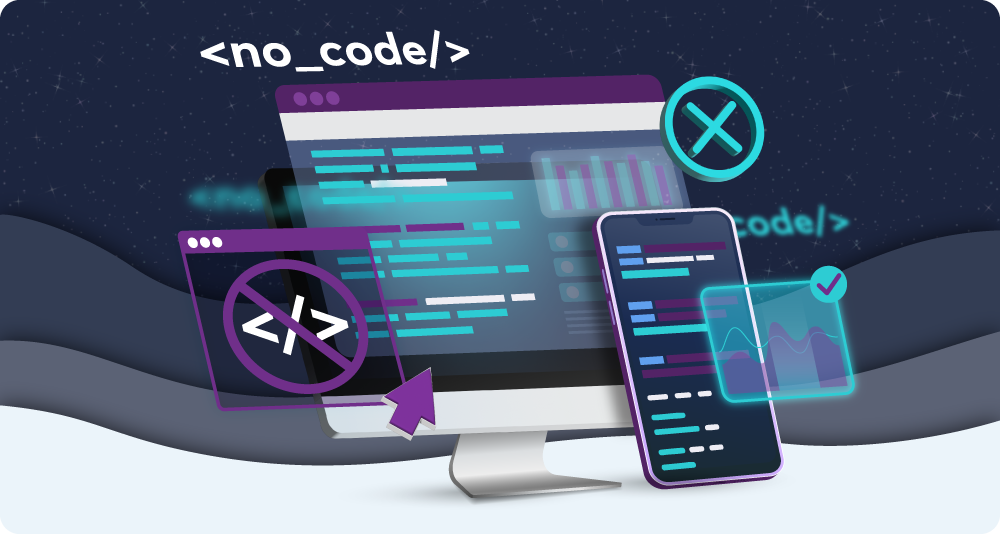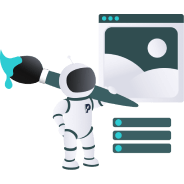

The Rise of No-Code / Low-Code Development
No-code and low-code web development platforms have revolutionised the way websites and applications are developed, as they have made it much easier for people without traditional coding skills to get creating. Let’s dive into what these platforms are, how they work, and why they are so beneficial for marketers:
No-code development
No-code platforms allow users to create software using graphical user interfaces and configurations instead of traditional computer programming. Users can drag and drop components to design their app or site, configure settings, and create workflows without writing a single line of code.
This approach democratises software development, enabling non-technical users to build applications quickly and with less dependency on IT departments or software developers.
Low-code development
Low-code platforms are a step above no-code in terms of complexity and flexibility. They provide a development environment where users can create applications through graphical user interfaces combined with minimal hand-coding. This approach is designed to speed up the development process but still allows developers to write code for more complex functionalities and integrations.
A short history of no-code and low-code web development
The concepts of no-code and low-code web development have been around in various forms for decades, but they began gaining significant popularity and mainstream acceptance in the 2010s.
The seeds of no-code and low-code development were planted in the 1980s-1990s with the advent of rapid application development (RAD) tools. Visual programming environments and
database management systems also had a part to play since they offered graphical interfaces for creating software applications.
Users were creating applications with tools like Microsoft Access and Visual Basic, which required less coding than usual. However, the foundations for modern no-code and low-code platforms were not set until the early 2000s. It was in this period that platforms simplified web development, however, they were aimed at professional developers wanting to accelerate development (rather than non-developers wanting to start from scratch).
The significant rise in popularity happened in the 2010s. This decade was a huge turning point due to several factors:
- The rise of cloud computing provided the necessary infrastructure for these platforms to operate efficiently, offering scalable solutions that could be accessed from anywhere.
- The global shortage of software developers made it imperative for businesses to find alternatives.
- Improvements in graphical user interfaces (GUIs), artificial intelligence (AI), and the standardisation of web technologies enabled the development of more powerful and user-friendly no-code and low-code platforms.
- Many platforms began offering pre-built templates, integrations, and plugins, making it easier for novices to use these applications.
Today, no-code and low-code platforms are super common. Businesses of all sizes leverage these tools for a wide range of uses, from internal tools and business processes to customer-facing apps and websites. The COVID-19 pandemic further accelerated this trend, as organisations sought to adapt to new ways of working and digital customer interactions.
The popularity of these tools continues to grow as the platforms become more sophisticated, offering solutions that are increasingly powerful, flexible, and capable of addressing complex development challenges.
Advantages and disadvantages of no-code/low-code web development
No-code and low-code development are recognised as key enablers of digital innovation, allowing organisations to respond quickly to market changes and opportunities without the traditional constraints of software development.
However, all innovations come with pros and cons. To get the most from their creations, business owners and marketers should be aware of both the benefits and challenges inevitable to these forms of development.
No-code and low-code web development aren’t the same thing, so their respective advantages and disadvantages should be considered separately:
| Advantages | Disadvantages | |
|---|---|---|
| No-code development | Accessibility – enables non-developers to create applications. Speed – reduces development time significantly. Cost-efficiency – can lower costs by reducing the need for experienced software developers for certain projects. |
Limited customisation – while highly flexible, there might be limitations in customisation and functionality. Scalability issues – some no-code platforms may not handle scaling to a large number of users or data size well. |
| Low-code development | Faster development – allows developers to produce applications quickly with pre-built templates and drag-and-drop interfaces. Flexibility – users can integrate custom code, offering more flexibility than no-code solutions. Increased productivity – developers can focus on more complex aspects of the development process, automating the more straightforward parts. |
Learning curve – while easier than traditional development, there’s still a learning curve to effectively use the platform. Potential for code complexity – mixing low-code solutions with custom code can lead to complex, hard-to-maintain codebases. |
How marketing professionals can benefit
Evidently, these platforms have a lot to offer. But how can their advantages be applied?
Here, we’re looking at how marketing professionals specifically can leverage these tools to enhance their campaigns, operations, and customer engagement:
-
- Marketers can quickly design and launch landing pages or microsites for specific campaigns, products, or events without waiting for web development resources.
- No-code platforms enable marketers to easily create personalised experiences for different segments of their audience by customising content, offers, and interactions based on user data.
- By using no-code and low-code platforms, marketing departments can execute many digital projects in-house without the constant need for IT or external developer resources, leading to significant cost savings.
- The savings achieved by using these platforms can be reallocated to other critical areas, such as ad spend, content creation, or market research.
- Marketers can use no-code tools to quickly prototype new ideas for apps, tools, or web functionalities and test them in the market, allowing them to be more agile.
- Feedback can be swiftly incorporated into designs or functionalities without going through lengthy development cycles, allowing for more agile and responsive marketing tactics.
- Platforms like Airtable and Zapier facilitate the collection and integration of data from various sources (website interactions, CRM, social media, etc.), enabling marketers to analyse customer behaviour and campaign performance more effectively.
- Automating repetitive tasks (e.g., email campaigns, social media posts, lead qualification) frees up time for strategic planning and creative work.
- No-code platforms allow marketers to maintain brand consistency across multiple channels by using templates and design tools that align with their branding guidelines.
- Marketers can quickly update content and promotions across their websites, mobile apps, and other digital platforms to ensure timely and relevant customer communication.
- By democratising the ability to create and manage digital assets, no-code and low-code platforms empower marketers to bring their creative ideas to life without technical barriers.
In summary, no-code and low-code platforms offer marketing professionals the tools to be more autonomous, agile, and creative. By enabling rapid development, customisation, and deployment of digital projects, these platforms help marketers respond quickly to market trends, engage customers more effectively, and achieve better results with fewer resources.
The most common uses of no-code and low-code development include business process applications (e.g., CRM systems and inventory management), websites and e-commerce platforms, and mobile apps.
How it works
Creating a website or application as a marketer without technical knowledge is entirely feasible today. These platforms are designed with simplicity and intuitiveness in mind, allowing you to bring your digital projects to life without writing code. But how do they really work?
Creative results are made possible through the features offered by these platforms. These are what allow users to design websites, shopping platforms, and apps without technical knowledge:
1. Templates
These platforms offer a wide range of pre-designed templates that serve as the foundation for your project. Templates are tailored for various purposes and industries, such as blogs, online shops, portfolios, and business sites.
Templates come with pre-designed layouts and design elements that you can customise.
2. Drag-and-drop interfaces
Drag-and-drop interfaces are fundamental to these development platforms, letting you visually construct your website or app and simply drag elements onto your canvas. This intuitive design process could include text boxes, images, buttons, and other interactive elements.
Most importantly, this feature eliminates the need for coding, because design choices are made on the front end.
3. Customisations
Customisation options allow you to modify the templates to fit your branding. This includes changing colours, fonts, and layouts, and adding your logo and images to make the design unique to your brand.
Beyond visual elements, many platforms also offer customisation for functionalities. This means you can add or remove features, integrate third-party services, and adjust settings to meet your specific requirements.
How to carry out your no-code/low-code project
By now you’re probably thinking of all the exciting things you can make with these easy-to-use platforms. To give you a good idea of what’s involved, read our step-by-step guide:
Step 1: define your project goals and requirements
- Determine whether you’re building a website, e-commerce platform, mobile app, or a specific business tool.
- List the features your project needs, such as forms, integration with email marketing tools, payment gateways, etc.
- Have a basic idea of the design and user experience you want to create. Sketching out a simple wireframe can be helpful for this step.
Step 2: choose a platform
Depending on your project type, different platforms might suit your needs better:
For websites and e-commerce:
- Wix: Offers intuitive drag-and-drop functionality, templates, and extensive app integrations. Wix is ideal for building professional websites without any coding.
- Squarespace: Known for its sleek templates and all-in-one solutions for building beautiful websites, portfolios, or online stores.
- Shopify: The go-to platform for e-commerce, providing everything you need to create an online store, manage inventory, and process payments.
For mobile apps:
- Adalo: Allows you to create mobile apps with a drag-and-drop interface. It’s great for building both iOS and Android apps without coding.
- Bubble: While it’s primarily used for web applications, Bubble also offers the flexibility to create mobile-friendly layouts and functionalities that can be wrapped into a mobile app.
For business tools and automation:
- Zapier: Perfect for automating workflows and connecting your app or website to other services without coding.
- Airtable: Acts as a database to manage your project’s data but with a spreadsheet’s simplicity. It can integrate seamlessly with other no-code tools to add backend functionalities.
Step 3: design and build
Use the platform’s templates as a starting point and customise them to match your brand’s identity. Prepare your content, including text, images, and videos. Many platforms offer stock images and design elements, but personalised content always stands out.
Build your product with the use of the features we mentioned earlier (templates, customisations, and drag-and-drop interfaces).
Step 4: test and optimise
Use the platform’s preview feature to test your website or app on different devices and browsers. It might be beneficial to gather feedback from potential users or stakeholders and make adjustments as necessary.
Don’t forget to utilise built-in SEO tools to optimise your site or app for search engines. This should include optimising loading times and navigation.
Step 5: launch, promote, and monitor your product
Once everything is polished and tested, it’s time to launch. Follow the platform’s guidelines to publish your site or distribute your app. Promote your new site or app through your usual marketing channels (e.g., social media and email marketing) as you normally would.
Once your product has been operational for a few weeks or months, you’ll want to use the platform’s analytics tools to monitor its performance. (You should be able to integrate your own analytics tools if you wish.)
If things come up and you want to update your product’s content or functionalities, the no-code or low-code development platform you’ve chosen is likely to allow for that very easily.
Final thoughts
No-code and low-code development platforms offer promising solutions to reduce the complexity, time, and cost of software development. By choosing the right platform and leveraging its features to the fullest, you can create professional, functional, and engaging digital products as a marketer. These innovative development tools really are a game-changer, so don’t be afraid to aim high with your new projects.











